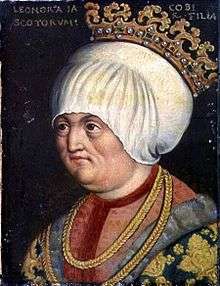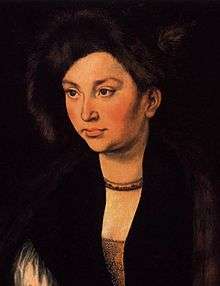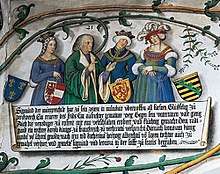Sigismund, Archduke of Austria
Sigismund (26 October 1427 – 4 March 1496), a member of the House of Habsburg, was Duke of Austria from 1439 (elevated to Archduke in 1477) until his death. As a scion of the Habsburg Leopoldian line, he ruled over Further Austria and the County of Tyrol from 1446 until his resignation in 1490.
Sigismund | |
|---|---|
| Archduke of Austria | |
_colour.jpg) Portrait by the Master of the Mornauer Portrait, circa 1470 (Alte Pinakothek, Munich) | |
| Born | 26 October 1427 Innsbruck, Tyrol |
| Died | 4 March 1496 (aged 68) Innsbruck |
| Buried | Stams Abbey |
| Noble family | House of Habsburg |
| Spouse(s) | Eleanor of Scotland Catherine of Saxony |
| Father | Frederick IV, Duke of Austria |
| Mother | Anna of Brunswick-Lüneburg |
Life
Sigismund (or Siegmund, sometimes also spelled Sigmund) was born at the Tyrolean court in Innsbruck; his parents were the Further Austrian duke Frederick IV of Austria and his second wife Anna of Brunswick, a daughter of the Welf duke Frederick I of Brunswick-Lüneburg. A minor upon his father's death in 1439, the Inner Austrian duke Frederick V, Sigismund's first cousin, acted as regent until 1446. Frederick, elected King of the Romans (as Frederick IV) in February 1440, exploited all opportunities to extend his influence over the Further Austrian lands. He also interfered in the Old Zürich War in order to regain the former Habsburg territories lost to the Swiss Confederacy, while the Tyrolean nobles urged him to cede the rule to Sigismund.

The mines of Tyrol remained an important source of revenue for Frederick and not until 1446, upon the end of his regency, Sigismund could accede to rulership over the Further Austrian (Vorderösterreich) possessions, which also included the Swabian territories of the Sundgau in southern Alsace, the Breisgau, and numerous smaller estates. His cousin had planned to marry him off to the French princess Radegonde, a daughter of King Charles VII the Victorious, however, she died in 1444 and Sigismund married Princess Eleanor of Scotland, the daughter of the Stewart king James I, in 1449.
Sigismund was able to acquire large parts of the former County of Bregenz (in present-day Vorarlberg) in 1451 and further estates in the Großwalsertal and Kleinwalsertal. Nevertheless, he had to cope with claims raised by Frederick's brother, Archduke Albert VI of Austria, and temporarily had to cede the rule over several Further Austrian territories to him. For much of his reign, he was engaged in disputes with Nicholas of Cusa, then Prince-bishop of Brixen and raised to Cardinal in 1449, for the control of the Tyrolean Eisack, Puster and Inn valleys. Sigismund sided with Nicholas' opponent Gregory of Heimburg and in 1460, when he marched against the bishop's residence at Bruneck Castle, he was excommunicated by Pope Pius II. Nicholas fled to Todi in the Papal States, but fell ill and died in 1464, before the archduke surrendered in order to receive the papal pardon.
In 1469, Sigismund sold several of his Swabian lands on the Rhine river, including the Alsace landgraviate, the County of Pfirt (Ferrette), the Breisgau and further cities, to the Burgundian Duke Charles the Bold. Sources are unclear, whether he sold them due to his debts he had accumulated owing to his luxurious lifestyle, or just "rented" them because he wanted to have them protected better against the expansion of the Swiss Confederacy. In turn, he extended his Vorarlberg possessions, purchasing the County of Sonnenberg in 1474 and, together with the Swiss (with whom he had concluded a peace treaty in Konstanz) and the Alsatian cities, he sided against Duke Charles of Burgundy in the Battle of Héricourt.

In 1477, his cousin Frederick, crowned Holy Roman Emperor in 1452, elevated him to Archduke. Three years later, Princess Eleanor died, and 1484, Sigismund married the 16-year-old Catherine of Saxony, daughter of the Wettin duke Albert III of Saxony. He had no offspring from either marriage.

In the later years of the 1470s and early 1480s Sigismund issued a decree that instituted a radical coinage reformation that eventually led up to the creation of the world's first really large and heavy silver coin in nearly a millennium, the guldengroschen, which the Habsburgs in Bohemia developed later into the thaler. This coin was the ancestor of many of the major European coin denominations to come later and also of the US dollar. Using new mining methods and technology, the largely quiescent silver mines in Tirol were brought back into production and soon numerous surrounding states were re-opening old mines and minting similar coins. This production of large coinage exploded as silver from Spain's colonies in the Americas flooded the European economy. It is from these reforms in part that Sigismund acquired the nickname of der Münzreiche, or "rich in coin".
Sigismund was easily swayed by the bad advice of his council and in March 1487 entered into a pointless war with the Republic of Venice, sometimes called the War of Rovereto. Tyrolean forces quickly seized silver mines in the Valsugana valley owned by Venice, and in April 1487 Sigismund outraged Venice further when he imprisoned 130 Venetian merchants traveling to the fair at Bozen (modern Bolzano) and confiscated their goods. Tyrol stormed the Pass of Calliano and later besieged the castle at Rovereto using a massive bombard, one of the earliest times such a large piece had been used in warfare. The war continued through summer but ended with no decisive victory for either side. One notable casualty of the conflict was the condottiero Roberto Sanseverino d'Aragona.
By 1490 the opposition of Tyrolean nobles compelled Sigismund to hand over the rulership to Frederick's son Archduke Maximilian I, who later succeeded his father as Holy Roman Emperor. Whether Sigismund voluntarily handed over power to Maximilian or was strongly coerced by the latter is not clear. With Sigismund's death in 1496, the Tyrolean branch of the Habsburg Leopoldian line became extinct, leaving Archduke Maximilian as sole heir to all the dynasty's possessions.

Ancestry
| 16. Albert I, King of the Romans | |||||||||||||||||||
| 8. Albert II, Duke of Austria | |||||||||||||||||||
| 17. Elisabeth of Carinthia | |||||||||||||||||||
| 4. Leopold III, Duke of Austria | |||||||||||||||||||
| 18. Ulrich III, Count of Pfirt | |||||||||||||||||||
| 9. Joanna of Pfirt | |||||||||||||||||||
| 19. Joanna of Burgundy | |||||||||||||||||||
| 2. Frederick IV, Duke of Austria | |||||||||||||||||||
| 20. Stefano Visconti | |||||||||||||||||||
| 10. Bernabò Visconti | |||||||||||||||||||
| 21. Valentina Doria | |||||||||||||||||||
| 5. Viridis Visconti | |||||||||||||||||||
| 22. Mastino II della Scala | |||||||||||||||||||
| 11. Beatrice Regina della Scala | |||||||||||||||||||
| 23. Taddea da Carrara | |||||||||||||||||||
| 1. Sigismund, Archduke of Austria | |||||||||||||||||||
| 24. Magnus I, Duke of Brunswick-Lüneburg | |||||||||||||||||||
| 12. Magnus II, Duke of Brunswick-Lüneburg | |||||||||||||||||||
| 25. Sophia of Brandenburg-Stendal | |||||||||||||||||||
| 6. Frederick I, Duke of Brunswick-Lüneburg | |||||||||||||||||||
| 26. Bernhard III, Prince of Anhalt-Bernburg | |||||||||||||||||||
| 13. Catherine of Anhalt-Bernburg | |||||||||||||||||||
| 27. Agnes of Saxe-Wittenberg | |||||||||||||||||||
| 3. Anna of Brunswick-Wolfenbüttel | |||||||||||||||||||
| 28. Rudolf I, Duke of Saxe-Wittenberg | |||||||||||||||||||
| 14. Wenceslaus I, Duke of Saxe-Wittenberg | |||||||||||||||||||
| 29. Agnes of Lindow-Ruppin | |||||||||||||||||||
| 7. Anna of Saxe-Wittenberg | |||||||||||||||||||
| 30. Francesco I da Carrara | |||||||||||||||||||
| 15. Cecilia da Carrara | |||||||||||||||||||
| 31. Fina Buzzaccarini | |||||||||||||||||||
See also
- Burgundy Wars
- Sigmundskron Castle
References
- Baillie-Grohnman, William Adolph (1907). The Land in the Mountains. Philadelphia: J. B. Lippincott Company. pp. 93–96.
- Coxe, William (1847). History of the House of Austria (third ed.). London: Henry G. Bohn, New York Street, Covent Garden.
- Van Dyke, Paul (1905). Renaissance Portraits. New York: Charles Scribner's Sons.
External links
| Wikimedia Commons has media related to Sigismund, Archduke of Austria. |
Sigismund, Archduke of Austria Born: 26 October 1427 Died: 4 March 1496 | ||
| Regnal titles | ||
|---|---|---|
| Preceded by Frederick IV |
Duke of Further Austria Count of Tyrol 1439-1490 |
Succeeded by Maximilian I |